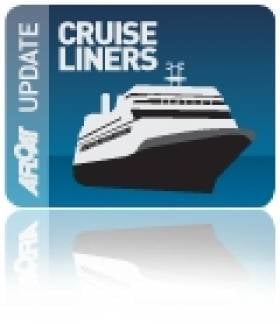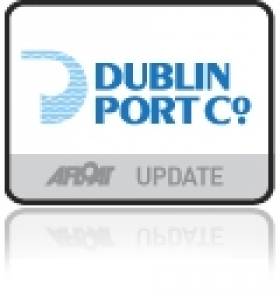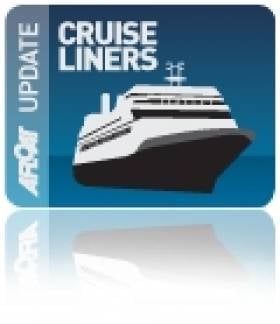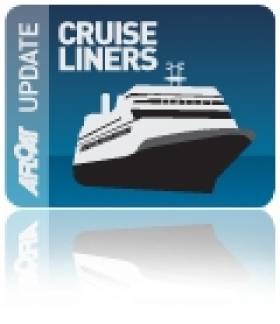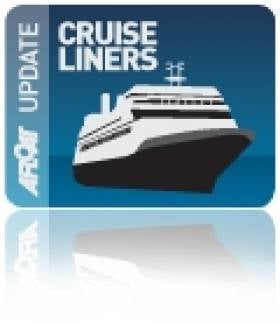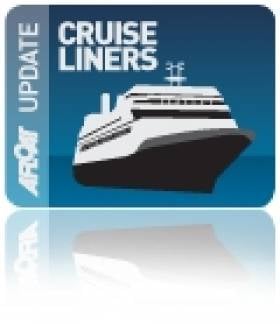Displaying items by tag: Princess Cruises
Biggest Cruiseship To Belfast Harbour This Year Makes A Regal Entrance
#cruiseliners - The biggest cruiseship to call to Belfast Harbour this year docked in the port this morning, writes Jehan Ashmore.
The impressive Regal Princess at 330m had berthed at Stormont Wharf Extension which is just 20m longer. The extension to the wharf having taken place in recent years to accommodate such ever increasing sized cruiseships.
On board there are up to 3,600 passenger who had sailed overnight from Greenock, Scotland as part of a 26 day Copenhagen to New York Cruise. The cruise includes visits to locations in Russia, Norway, Germany, Estonia, Finland, Sweden and Denmark.
Today's visit by passengers to Belfast and beyond will almost be 8-hours, however in the context of the cruiseship, this is the fourth visit. The inaugural call was in 2003.
By the end of 2017, it is estimated that Belfast Harbour will play host to 150,000 cruise visitors. As the city port is the gateway for international visitors to visit the many sights and attractions of the city and throughout Northern Ireland has to offer.
Asides Princess, the port's cruise clients include other big names such as Celebrity, Silversea, Majestic, Fred Olsen and relative newcomer Cruise & Maritime Voyages (CMV).
A late afternoon departure is scheduled for Regal Princess which will make an overnight passage through the Irish Sea. The next port of call is Cobh, Cork Harbour.
#RecordOilFine- A US$40m penalty is to be paid by Princess Cruises after pleading guilty to seven federal charges in an illegal ocean pollution case that involved one ship’s use of a so-called 'magic pipe' to divert oily waste into UK waters, writes The Guardian.
Miami US attorney Wifredo Ferrer told a news conference the penalty was the largest ever of its kind. A plea agreement filed in federal court also requires Carnival, the UK and US-listed parent company of the Princess line, to submit 78 cruise ships across its eight brands to a five-year environmental compliance programme overseen by a judge.
Ferrer said the illegal practices came to light when an engineer aboard the Caribbean Princess discovered the “magic pipe” in 2013 off the coast of Britain and told investigators about it.
Authorities later learned the 952ft ship had been illegally discharging oily water into the ocean since 2005.
“Our open seas are not dumping grounds for waste,” Ferrer said. “One thing we must never do is take our clear blue oceans for granted.”
A single illegal discharge dumped 4,227 gallons of oil-contaminated waste about 20 miles off the coast of England on 26 August 2013, according to court documents.
The documents also show illegal practices were found on four other Princess ships, including use of clean ocean water to fool onboard sensors that would otherwise detect dumping of improperly contaminated bilge water. Authorities say cost savings was the motive and that the ship’s officers and crew conspired to cover up what was going on.
John Cruden, assistant attorney general for the US justice department’s environmental division, said the Caribbean Princess “violated the law, they covered it up and then they lied about it”.
“We’re sending a strong message in this case to the entire industry.”
To read more on a statement released from Princess Cruises click here.
In August this year Afloat covered the story of a power failure on Caribbean Princess bound for Dublin Port which rendered the vessel adrift for nine hours on the Irish Sea.
Afloat.ie adds that Caribbean Princess is to call to Dublin Port in season 2017 as the most frequent of any cruiseship with 13 separate visits. The giant 112,894 gross tonnage vessel with a guest capacity of 3,142 (lower berths) is scheduled to make the first call in April.
The Carnival subsidiary will also see Pacific Princess calling to Dublin. Described by Princess as the 'small cruiseship experience' given the 30,277 gross tonnage and only 672 (lower berths) capacity vessel which is to make three calls. Together these cruiseships will total 16 calls calling to the capital.
#CorkCruiseDouble – Cork Harbour today welcomed two very large cruiseships, though at separate locations due to the combined length of these impressive vessels, writes Jehan Ashmore.
The larger of the two Princess Cruises callers, the 330m long Royal Princess named by Catherine, Duchess of Cambridge, in 2013, entered Cork Harbour after the Caribbean Princess. The later cruiseship albeit smaller at 290m is still a large vessel in terms of those calling to an Irish port.
Royal Princess of all 141,000 gross tonnes has a 3,600 passenger /1,300 crew total and had berthed alongside Cobh from where her newer sister Regal Princess also called late last month.
More cruiseships from the Carnival Corporation brand have visited Cobh down through the years among them Cunard Line's Queen Elizabeth.
Elder sister Queen Victoria as previously reported is on a 'Remembering Lusitania' commemorative cruise to Cobh this Thursday, the day the liner sank a century ago during WWI when U-Boat 20 fired a torpedo that led to a huge loss of life.
Royal Princess had sailed from Ponta Delgada, Azores and likewise the 112,894 tonnes Caribbean Princess with up to 3,100 passengers.
Another double-take is that both vessels were built by Fincantieri in Monfalcone, Italy and equally they draw the same draft of 8.5m.
As previously reported on Afloat.ie, the cruise-quay facility at Cobh recently underwent phase one of €1.5m upgrade to facilitate even larger cruiseships, notably RCI's mega 'Quantum' class of 347m in length. These massive 168,000 tonnes cruiseships with almost 5,000 passengers are expected to visit the Port of Cork's Cobh Cruise Terminal but not until at least 2017.
The facility can currently accommodate two cruiseships at the same time though in comparison notably smaller sized ships to what the future holds.
So where in the case of today's double call scenario did the 3,100 passenger Caribbean Princess go to berth? The large 'Grand' class cruiseship had sailed beyond Cobh to another deepwater quay alongside Ringaskiddy.
This is where Cunard Line's 'liner' 'QE2' had berthed as well as to Cobh where she bade her final farewell visit in 2008. Her successor Queen Mary 2 has made calls to the lower Cork Harbour town cruise destination.
As for the Princess pair they are scheduled to depart this evening half an hour apart from 20.00hrs. In total the port is expected to see 55 cruise calls this season.
#PrincessCallers -Dublin Port's main cruise berths that line along the broad width of Ocean Pier are both occupied by a pair of Princess Cruises ships that docked at dawn today, writes Jehan Ashmore.
Ruby Princess, a 'Grand' class ship of 113,000 tonnes arrived overnight from calling to Cobh. She had moored alongside Ocean Pier within Alexandra Basin west at berth 37. Towering 19 decks high, she can accommodate more than 3,000 passengers.
While facing opposite on the adjacent quay, Ocean Princess of 30,000 tonnes, is one of the smaller members of the Princess fleet, which berthed at the appropriately named pier at berth 33 in the eastern basin. The 9-deck high former Renaissance Cruises vessel can handle almost 700 guests. The mostly adult carrying cruiseship had previously called to Milford Haven in Pembrokeshire.
Combined the potential capacity of the contrasting sized Bermuda flagged ships is some 3,700 passengers and the crew alone totals for more than 1,500 personnel.
Take a peak of the luxurious facilities by clicking each of the highlighted ships names as above and which will also lead you to facts about the vessels.
An evening departure of the pair is 'scheduled' for 18,00hrs and should provide an interesting viewing opportunity (South Wall breakwater) to contrast the sheer scale between these ships.
There are still plenty more cruise callers due to Dublin Port this season, click for details HERE.
Cruiseship on Atlantic Repositioning Cruise
#ATLANTIC REPOSITIONING CRUISE – Another massive cruiseship the Caribbean Princess (2004/112,894grt), is to dock in Dublin Port around lunchtime today, having crossed the Atlantic, from Halifax, Nova Scotia in Canada, writes Jehan Ashmore.
The 3,600 passenger capacity 'Grand' class ship operated by Princess Cruises is on a repositioning cruise voyage from North America to Europe. She is to spend the season running cruises based out of Southampton.
Caribbean Princess retains her 'Skywalkers' Nightclub mounted 15 decks at the stern, unlike her sister which called to Dublin Port last month. The structure was removed primarily on grounds of weight so to increase fuel efficiency.
The Bermuda flagged vessel is to berth at Ocean Pier in the centre of the docks which this season is to welcome a total of 90 cruiseships bringing 100,000 passengers contributing €35- €50m to the Dublin economy in 2012. It is estimated that the cruise sector has contributed over €350 million to the capital in the last decade.
Vessels such as the Caribbean Princess and larger-sized ships could be a familar sight closer to the city-centre should proposals to build a €30m dedicated cruise terminal take-off at a site adjacent to the East-Link Bridge, as part of the Dublin Port Company's Masterplan 2012-2040.
‘Lost Weight’ Cruiseship to Call to Dublin Port
#CRUISE LINERS – Following Friday's first cruise call to Dublin Port this year of the 300-plus passenger Arion as previously reported, the considerably larger Grand Princess is to call on Wednesday. Notably on this occasion the 2,600 passenger cruiseship is to appear without her signature 'Skywalker' Nightclub, which used to be perched 18 decks-high at the aft of the vessel, writes Jehan Ashmore.
The aptly named nightclub was built on two legs to form a bridge (see PHOTO) and was accessed by a glass gangway. Not only was the structure at such an elevated position but it also overhang beyond the sheer of the stern superstructure below, where clubbers had bird's eye views over the oceans and to numerous ports of calls.
In an operation to remove the Skywalker last year, the structure weighing 211 tons took over 10 hours to complete (as previously reported including VIDEO of the work). The reason for removing the nightclub according to her owners Princess Cruises was to 'significantly improve the operational performance of the ship, including greater fuel efficiency.' For a post dry-docking view click PHOTO.
During the procedure at the Grand Bahama Shipyard in the US, the opportunity included the installation of a new nightclub three decks below and was named One5.
Ironically before the vessel lost weight!....she was the first cruiseship to visit Dublin Port to surpass the 100,000 tonnes milestone, when the leadship of the 'Grand' class docked in 2004.
From Falmouth to the Fjords
#CRUISE LINERS – Dublin Port's first cruise caller for this season will be Arion which today sets sail from Falmouth on an eleven night / twelve day cruise to Scotland and Norwegian fjords. The 5,888 gross tonnes cruiseship built in 1965 is to berth in the capital at Ocean Pier, writes Jehan Ashmore.
The veteran vessel which has sleek traditional lines can carry over 300 passengers and she is operated by Classic International Cruises. Her visit will be one of around 90 cruise calls scheduled to Dublin Port during this year's season which stretches to early October. The majority of these calls will be in the summer and where several ships will be making repeat port of calls.
With so many callers to Dublin Port, this brings a greater variety of vessels as evident between the Arion and Princess Cruises considerably larger Grand Princess which is due next week. The giant vessel weighs over 109,000 gross tonnes and has a capacity for over 4,000 passenger and crew.
The Portuguese flagged Arion is also set to open the season to Galway, as previously reported she is to make an anchorage call off the mid-west harbour next month.
Meanwhile following all the recent focus centred in Cobh, Cruise & Maritime Voyages Marco Polo is expected to arrive this afternoon by berthing at the town's dedicated cruiseship quayside.
Cruiseship Boost for Belfast
#CRUISE LINERS-Belfast Harbour looks forward to another bumper year as cruise operators are to increase by 32% compared to last year, with 41 cruise ships bringing almost 75,000 visitors to the port.
The following major operators are to visit: Cruise & Maritime Voyages, Fred Olsen Cruise Lines, Holland America Line, Princess Cruises and Saga Cruise and others will dock from far flung destinations.
At over 1km long, Stormont Wharf, will again be the main berth for cruiseships in particular the ability to accommodate an increasing trend in larger class vessels touring the Irish Sea. The wharf was extended in recent years at a cost of £10m and is the longest deepwater quay in Ireland.
To promote Belfast Harbour as a cruiseship destination, the port and the Belfast Visitor and Convention Bureau (BVCB) set up the Cruise Belfast Initiative to market the location internationally.
For further information visit www.cruise-belfast.co.uk and to view the seasons schedule of cruise callers click HERE.
Cruiseships Great and Small Lineup for Dublin 2012
#CRUISE LINERS- Around 85 cruiseships are scheduled to call to Dublin Port in 2012, which compares closely to the same number of calls for this year's season, writes Jehan Ashmore.
First to start the season will be Grand Princess, which has the accolade of being the inaugural cruiseship to enter the port with a tonnage surpassing the 100,000 gross tonnes. The milestone was marked by the Princess Cruises call in 2004.
As usual with that number of cruise-callers, the variety of vessels will range from the small to the very large. A prime example is the diminutive expedition cruiseship Quest (1,180 tonnes) and at just under 50-metres long has just over the same number in passenger capacity.
In complete contrast to the ice-strenghtened Quest is the giant Caribbean Princess, a larger sister of Grand Princess, can accommodate over 3,000 passengers and she is make several calls.
Noble Caledonia which has been operating Quest (PHOTO) on successful seasons in Scotland, is to embark on itineraries next season to Ireland, England and Wales for the first time. Her half-sister Ocean Nova has called to Dublin on previous occasions.
For only the second time, Queen Elizabeth is due return to the capital (for report click HERE) in late Summer and in the same week, Hebridean Princess is also scheduled to call. The later vessel in recent years was chartered to Queen Elizabeth II, for a cruise off the Scottish Isles. To read more on the small ship's visit to the port earlier this year click HERE.
Cruiseships Head for Cobh in advance of Queen Elizabeth
The 2,500 passenger Jewel of the Seas has a nine-deck centrum which has glass lifts which allows light to flow throughout the spacious and airy ship. Activities range from golf to climbing, a spa and sumptuous restaurants.
When the 2004 built cruiseship docks at the dedicated cruise berth at Cobh in the early hours of tomorrow she will also be sharing the deepwater berth with the 2001 built Silver Whisper. The ultra-luxury vessel accommodates only 388 passengers and is operated by SilverSeas Cruises. To read more about the vessel click HERE.
Both vessels are scheduled to depart Cobh around teatime tomorrow and this will be followed by preparations of the picturesque town which is to welcome the maiden call to Cobh of Queen Elizabeth on Saturday. To read more about the newest vessel of the Cunard Line fleet click HERE. The 2010 built vessel will firstly make an inaugural call to Dublin on Friday prior to the Cobh call which coincides with Cork Harbour Open Day, for event details visit www.corkharbour.ie




























